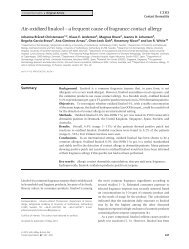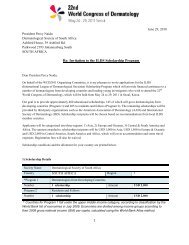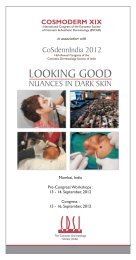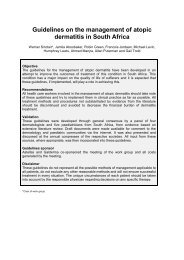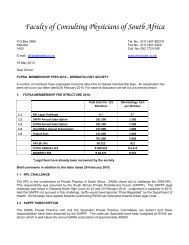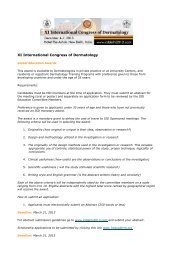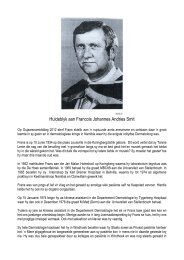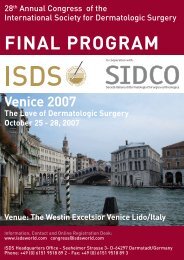History of the Dermatology dept UCT.
History of the Dermatology dept UCT.
History of the Dermatology dept UCT.
You also want an ePaper? Increase the reach of your titles
YUMPU automatically turns print PDFs into web optimized ePapers that Google loves.
1066 SAMJ VOLUME 67 29 JUNE 1985<br />
Moorrees Bosman, was a person <strong>of</strong> strong personality, very<br />
experienced in all phases <strong>of</strong> dermatology, and <strong>the</strong>re was <strong>the</strong>refore<br />
no doubt in <strong>the</strong> minds <strong>of</strong> his staff that under such<br />
guidance <strong>the</strong> department could only go from strength to<br />
strength.<br />
Although we were dependent on <strong>the</strong> Department <strong>of</strong> Pathology<br />
for our histological examinations, this service had now<br />
reached such a hjgh standard, and <strong>the</strong> head <strong>of</strong> that department<br />
was so co-operative, that we were quite ready to undertake<br />
postgraduate training as well.<br />
In 1940 I went on active service, and unfortunately in 1941<br />
Dr Bosman had to be granted sick leave and thus <strong>the</strong> burden<br />
<strong>of</strong> carrying on rested on <strong>the</strong> shoulders <strong>of</strong> Drs Krone and<br />
Jacobson. The work had increased considerably and, fortunately<br />
for everyone concerned, two <strong>of</strong> our graduates, Dr Jean Walker<br />
and Dr Doris Hersman, had decided to specialize in dermatology<br />
and were duly appointed clinical assistants in <strong>the</strong><br />
department. After working in <strong>the</strong> department for 3 years, <strong>the</strong>y<br />
were duly registered as dermatologists in 1942 and subsequently<br />
appointed registrars. Dr Doris Hersman has remained on <strong>the</strong><br />
staff ever since, and Dr Jean Walker, after a break when she<br />
practised dermatology in Port Elizabeth, returned to us later<br />
in a full-time capacity. Thus <strong>the</strong> careful planning and vision <strong>of</strong><br />
our former chief bore fruit, in that we were able to train two<br />
such excellent candidates.<br />
In 1944 Dr Krone resigned on account <strong>of</strong> ill-health, followed<br />
<strong>the</strong> next year by <strong>the</strong> resignation <strong>of</strong> Dr Bosman for <strong>the</strong> same<br />
reason. In 1945 I was appointed head <strong>of</strong> <strong>the</strong> teaching department<br />
<strong>of</strong> <strong>the</strong> University as well as head <strong>of</strong> <strong>the</strong> department at<br />
Groote Schuur Hospital.<br />
The resignation <strong>of</strong> Drs Bosman and Krone was a great loss<br />
to us. As we were now very short-staffed, we were only too<br />
pleased to retain <strong>the</strong> services <strong>of</strong> Drs Rebecca Katz, J. Selkon<br />
and 1. \Voolfsohn, general practitioners who had rendered<br />
great help to Dr Bosman and his colleagues during <strong>the</strong> war<br />
years.<br />
In 1947 <strong>the</strong> late Dr H. Krafchik, who had in <strong>the</strong> meantime<br />
specialized in dermatology, joined <strong>the</strong> department, and I need<br />
hardly say that this was a welcome addition to our establishment.<br />
However, <strong>the</strong> great need for younger people to specialize<br />
in <strong>the</strong> subject was forever foremost in our minds and as head<br />
<strong>of</strong> <strong>the</strong> department I <strong>the</strong>refore eagerly welcomed a younger<br />
man in <strong>the</strong> person <strong>of</strong> Dr Sidney Stein who became a postgraduate<br />
student in dermatology in 1948 and registrar in <strong>the</strong><br />
department in 1949, completing his training in Britain and<br />
finally joining our staff as a specialist dermatologist in 1952.<br />
The new system<br />
In 1950 revolutionary changes took place in all departments <strong>of</strong><br />
<strong>the</strong> hospital. The honorary system was abolished and a joint<br />
agreement was drawn up between <strong>the</strong> University and <strong>the</strong><br />
Provincial Administration whereby <strong>the</strong> departments were now<br />
paid on a sessional basis. We lost our complete autonomy and<br />
were now made part <strong>of</strong> <strong>the</strong> medical division. We were given an<br />
establishment consisting <strong>of</strong> one G pOSt, one E post and one C<br />
post.<br />
<strong>Dermatology</strong>, like all o<strong>the</strong>r branches <strong>of</strong> medicine, has<br />
advanced tremendously over <strong>the</strong> past decade, and if we are to<br />
majntajn our standards we must be given scope for advancement.<br />
This cannot be done under <strong>the</strong> present rigid establishment.<br />
Wherein lies <strong>the</strong> fault that so few young candidates have<br />
come forward to be trained in dermatology? Tever had we had<br />
closer relationships with our parent subject, medicine, and <strong>the</strong><br />
head <strong>of</strong> our djvision has given us every opporturuty to improve<br />
our standard <strong>of</strong> general medicine, so essential to <strong>the</strong> complete<br />
dermatologist. Yet this does not alter <strong>the</strong> fact that great<br />
controversy still exists in medical schools, not only in Britain<br />
but also in <strong>the</strong> Americas and on <strong>the</strong> Continent, that dermatology<br />
has now grown to vigorous manhood and should be<br />
sufficiently independent to develop its own line <strong>of</strong> research.<br />
To do this needs finance, which can never be adequately<br />
supplied while we are a small section <strong>of</strong> a large group. Once<br />
we reach this stage, I am sure <strong>the</strong> department could attract<br />
young men who have received prior training in general medicine.<br />
At <strong>the</strong> time <strong>of</strong> reorganization no member <strong>of</strong> our staff had<br />
any desire to take up a full-time post, and <strong>the</strong> existing sessions<br />
were <strong>the</strong>refore divided among <strong>the</strong>m, leaving only <strong>the</strong> C post<br />
vacant. The result was that I had to persuade Dr Jean Walker,<br />
who had previously resigned as honorary assistant dermatologist,<br />
to occupy this lowly post. There were, however, many<br />
advantages attached to this, since <strong>the</strong> medical library had<br />
expanded tremendously and she was thus in a position to<br />
devote herself to extensive study <strong>of</strong> dermatological literature.<br />
In addition, she had ample opportunity to keep abreast <strong>of</strong><br />
general medicine by attending various seminars in that subject.<br />
No candidate could hold <strong>the</strong> registrar's post for longer than<br />
3 years and at <strong>the</strong> end <strong>of</strong> <strong>the</strong> period when her promotion was<br />
due, we struck a snag in our rigid establishment; it was only<br />
through <strong>the</strong> generosity <strong>of</strong> <strong>the</strong> part-time staff in sacrificing<br />
some <strong>of</strong> <strong>the</strong>ir pay that we were in <strong>the</strong> position to clear <strong>the</strong> post<br />
as a full-time one. That this was a necessity was amply<br />
justified subsequently by <strong>the</strong> research instituted, and <strong>the</strong> great<br />
assistance given to me in our joint publications on some <strong>of</strong> <strong>the</strong><br />
rarer dermatoses. Dr Jean Walker was our first graduate to<br />
receive an M.D. with dermatology as a major subject, <strong>the</strong> title<br />
<strong>of</strong> her <strong>the</strong>sis being 'Skin and tuberculosis'.<br />
In 1950 <strong>the</strong> late Dr J. Lipshitz was appointed to <strong>the</strong><br />
department as a part-time dermatologist and remained with us<br />
until his premature death in 1957. In 1958 Dr Krafchik passed<br />
away.<br />
In <strong>the</strong> meantime, Dr Jean Walker had resigned her full-time<br />
post to start in private practice, and with 3 vacancies on our<br />
staff we were indeed fortunate to obtain <strong>the</strong> services <strong>of</strong> Dr C.<br />
K. O'Malley, whose presence added colour to our department<br />
and whose death in 1961 left a void. Subsequently, Dr H. van<br />
de Meulen, who had been assistant to <strong>the</strong> pr<strong>of</strong>essor <strong>of</strong> dermatology<br />
in Batavia, was appointed to one <strong>of</strong> <strong>the</strong> still-vacant posts.<br />
In October 1958 Dr R. Kooij, who had been chief assistant<br />
to Pr<strong>of</strong>essor Prakken in Amsterdam and subsequently research<br />
<strong>of</strong>ficer at <strong>the</strong> Westford Leprosy Institution in Pretoria, was<br />
appointed to <strong>the</strong> vacant full-time post. In him we have a<br />
research worker <strong>of</strong> <strong>the</strong> first flight, and I am sure that as soon<br />
as our laboratory, which has been promised to us for so long<br />
by <strong>the</strong> University and <strong>the</strong> Provincial Administration, comes<br />
into existence, <strong>the</strong> necessary research to keep <strong>the</strong> department<br />
alive will finally bring us up to internarjonal standard; particularly<br />
in view <strong>of</strong> <strong>the</strong> fact that in <strong>the</strong> past few years we have had<br />
to train 3 postgraduate students in dermatology.




